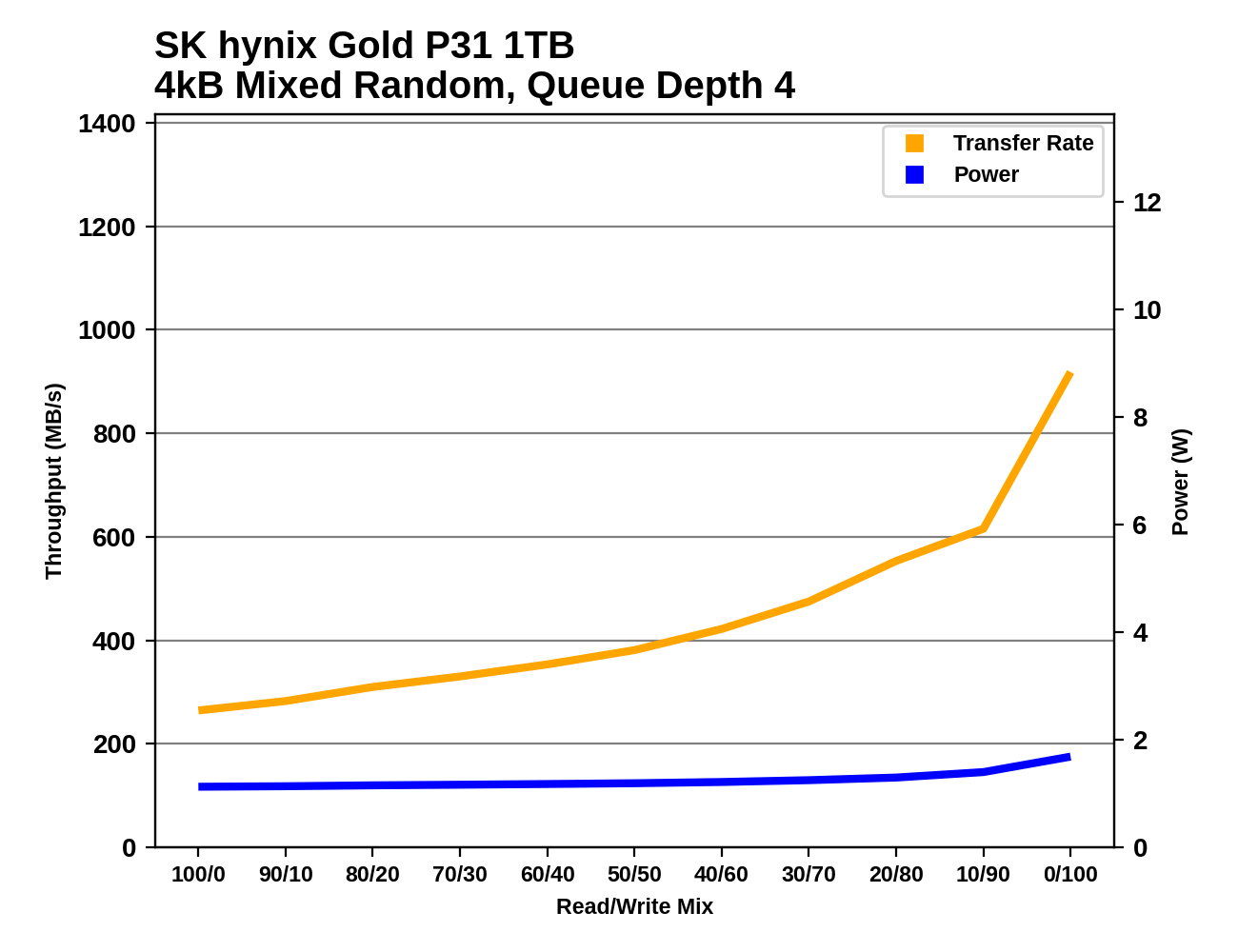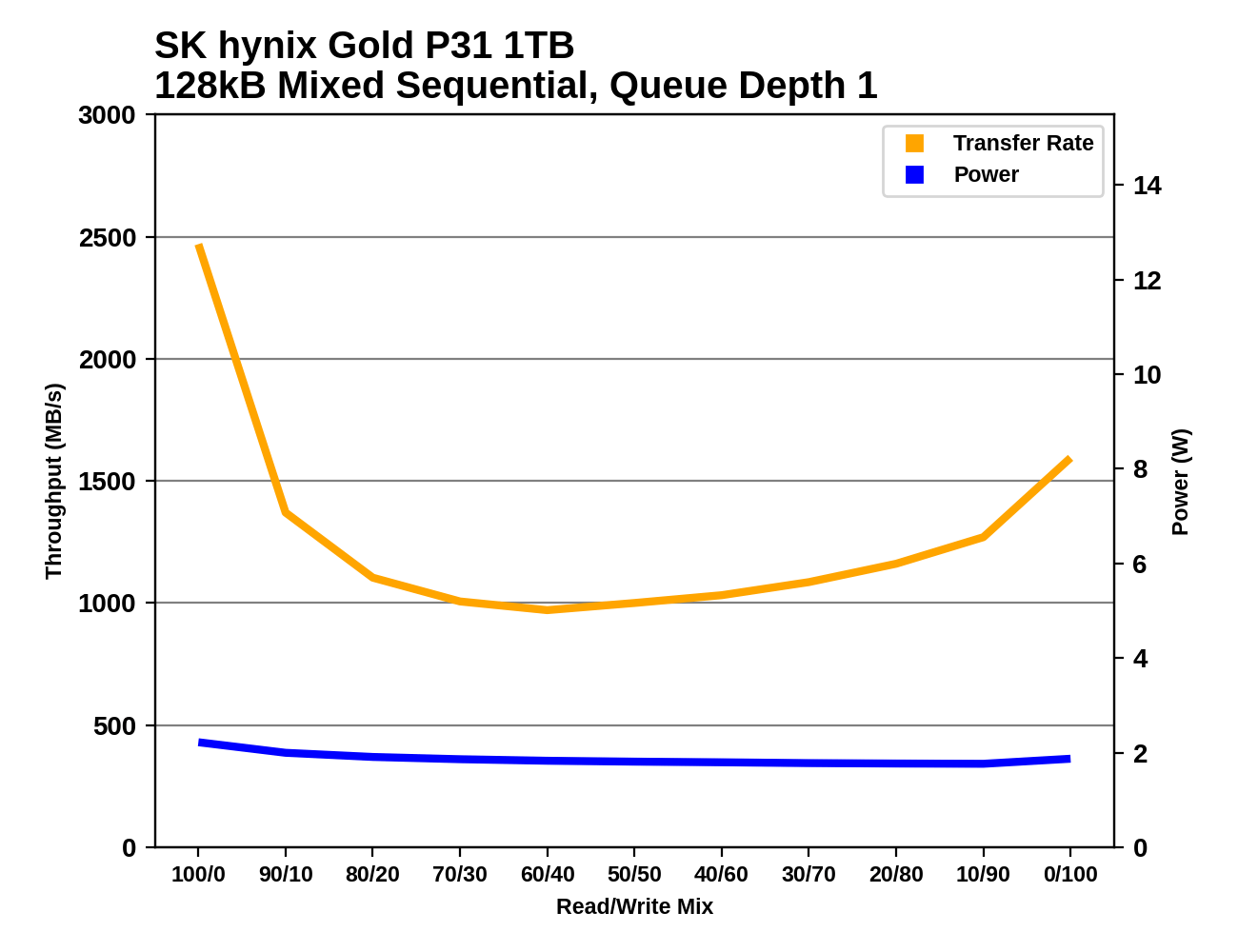The Best NVMe SSD for Laptops and Notebooks: SK hynix Gold P31 1TB SSD Reviewed
by Billy Tallis on August 27, 2020 8:00 AM ESTMixed Random Performance
Our test of mixed random reads and writes covers mixes varying from pure reads to pure writes at 10% increments. Each mix is tested for up to 1 minute or 32GB of data transferred. The test is conducted with a queue depth of 4, and is limited to a 64GB span of the drive. In between each mix, the drive is given idle time of up to one minute so that the overall duty cycle is 50%.

The Intel Optane 905P holds on to a very comfortable performance lead on our mixed random IO test, but the SK hynix Gold P31 raises the bar for TLC-based SSDs by about 10%.
 |
|||||||||
| Power Efficiency in MB/s/W | Average Power in W | ||||||||
The Gold P31 has the lowest average power consumption on this test out of all the drives in this batch, which naturally leads to a massive lead in power efficiency: it delivers twice the performance per Watt of the next best drive.
 |
|||||||||
Compared to other high-end TLC-based SSDs, the Gold P31 performs best during the more read-heavy phases of this test. Several competitors catch up to it and a few surpass it during the most write-intensive portions of the test, but that also tends to be where the P31's power usage advantage is widest.
Mixed Sequential Performance
Our test of mixed sequential reads and writes differs from the mixed random I/O test by performing 128kB sequential accesses rather than 4kB accesses at random locations, and the sequential test is conducted at queue depth 1. The range of mixes tested is the same, and the timing and limits on data transfers are also the same as above.

The mixed sequential read/write performance of the SK hynix Gold P31 is unimpressive. For once, its performance is about what we'd expect from a drive designed more for efficiency than raw performance. However, it still has an 18% lead over the slowest 8-channel drive in this batch.
 |
|||||||||
| Power Efficiency in MB/s/W | Average Power in W | ||||||||
The Gold P31 still completes this test with remarkably low power consumption (averaging less than 2W), but the relatively modest performance means its efficiency score is only about 33% above the next best drive in this bunch.
 |
|||||||||
After starting out with a good sequential read speed, the SK hynix Gold P31's performance drops steeply when writes are added to the mix. It bottoms out just below 1GB/s with a 60% reads mix, and then gradually recovers performance to finish with a fairly typical sequential write speed. Power consumption from the P31 doesn't vary much across the test, and it's only above 2W at the very beginning of the test.










80 Comments
View All Comments
surt - Thursday, August 27, 2020 - link
Am i the odd one out that hasn't needed to use a hard drive tool in years?HardwareDufus - Thursday, August 27, 2020 - link
i don't think so. i've been in the industry for over 30 years. back in those days, some harddrives came with error lists that you had to key into a system bios. then there were all the size limits that require creating multiple partitions... the list goes on...but I think other than running scan disk once a year and my scheduled trims.... I haven't used a harddrive tool on my personal PCs and laptops for over 8 years.
plopke - Thursday, August 27, 2020 - link
For me only once with Samsung it was needed , the other times where it was offered but not needed was crucial /sandisk for slight improved performance or compatibility. I just found it very awkward to not have a website showing specifications or support tools at all.Holliday75 - Thursday, August 27, 2020 - link
Nope. I have no updated the firmware on a SSD in 5+ years. That includes work.MikeMurphy - Friday, August 28, 2020 - link
My practice is to update firmware before I install a fresh copy of Windows. Often I'm greeted with some improved firmware for which I'm grateful. I've been happy with the support on my Crucial, Intel and Samsung drives.TheinsanegamerN - Monday, August 31, 2020 - link
Literally have never updated firmware on any SSD. Also only had issues with 1 SSD where the controller straight up died.Tomatotech - Thursday, August 27, 2020 - link
I've only ever used them as a last resort when trying to rescue a failing SSD (and I've had a couple) - they were useless anyway, might as well not bother. Both times when the drive died the manufacturer happily replaced the drive.With today's cloud tech it's easier than ever to keep a 1TB drive constantly backed up & synced (different things) to several different places. OneDrive offers 1TB, iCloud offers 2TB, etc, and usually anything apart from office docs, project files, and photos doesn't even need to be backed up.
TheinsanegamerN - Monday, August 31, 2020 - link
That only applies to the 1% who can get fiber internet. Ever try to back up 1TB of stuff over a cable connection, usually with a 3-5Mbps upload speed?For most people an external HDD is more usable as a backup method then any cloud storage.
Srikzquest - Thursday, August 27, 2020 - link
Hi Billy, I see that the benchmarks are equally compelling on the performance side as well in addition to power efficiency. Then, why its only the standard for Laptops and not Desktops. Is it due to PCIe gen4 drives on the market?Billy Tallis - Thursday, August 27, 2020 - link
The P31 is definitely a good choice for desktops, but it's not the only reasonable choice—while for laptops, it pretty much is at the moment. Since desktop users have little reason to worry about SSD power efficiency, it can make sense to go with something like a cheaper, somewhat slower Phison E12 drive or even something more low-end, because the real-world performance difference between the P31 and a decent low-end NVMe drive (or even a good SATA drive) is pretty small for most use cases. There's also the 2TB market to consider, since the Platinum P31 isn't available yet.